Actin filaments at the leading edge of cancer cells are characterized by a high mobile fraction and turnover regulation by profilin I
- PMID: 24465723
- PMCID: PMC3895011
- DOI: 10.1371/journal.pone.0085817
Actin filaments at the leading edge of cancer cells are characterized by a high mobile fraction and turnover regulation by profilin I
Abstract
Cellular motility is the basis for cancer cell invasion and metastasis. In the case of breast cancer, the most common type of cancer among women, metastasis represents the most devastating stage of the disease. The central role of cellular motility in cancer development emphasizes the importance of understanding the specific mechanisms involved in this process. In this context, tumor development and metastasis would be the consequence of a loss or defect of the mechanisms that control cytoskeletal remodeling. Profilin I belongs to a family of small actin binding proteins that are thought to assist in actin filament elongation at the leading edge of migrating cells. Traditionally, Profilin I has been considered to be an essential control element for actin polymerization and cell migration. Expression of Profilin I is down-regulated in breast and various other cancer cells. In MDA-MB-231 cells, a breast cancer cell line, further inhibition of Profilin I expression promotes hypermotility and metastatic spread, a finding that contrasts with the proposed role of Profilin in enhancing polymerization. In this report, we have taken advantage of the fluorescence recovery after photobleaching (FRAP) of GFP-actin to quantify and compare actin dynamics at the leading edge level in both cancer and non-cancer cell models. Our results suggest that (i) a high level of actin dynamics (i.e., a large mobile fraction of actin filaments and a fast turnover) is a common characteristic of some cancer cells; (ii) actin polymerization shows a high degree of independence from the presence of extracellular growth factors; and (iii) our results also corroborate the role of Profilin I in regulating actin polymerization, as raising the intracellular levels of Profilin I decreased the mobile fraction ratio of actin filaments and slowed their polymerization rate; furthermore, increased Profilin levels also led to reduced individual cell velocity and directionality.
Conflict of interest statement
Figures
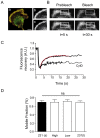
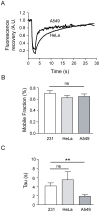

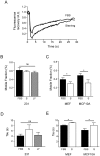
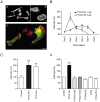

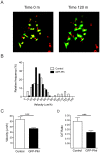
Similar articles
-
Differential remodeling of actin cytoskeleton architecture by profilin isoforms leads to distinct effects on cell migration and invasion.Cancer Cell. 2012 Nov 13;22(5):615-30. doi: 10.1016/j.ccr.2012.09.027. Cancer Cell. 2012. PMID: 23153535 Free PMC article.
-
Profilin connects actin assembly with microtubule dynamics.Mol Biol Cell. 2016 Aug 1;27(15):2381-93. doi: 10.1091/mbc.E15-11-0799. Epub 2016 Jun 15. Mol Biol Cell. 2016. PMID: 27307590 Free PMC article.
-
Profilin-1 versus profilin-2: two faces of the same coin?Breast Cancer Res. 2013 Jun 27;15(3):311. doi: 10.1186/bcr3433. Breast Cancer Res. 2013. PMID: 23827010 Free PMC article.
-
Molecular insights on context-specific role of profilin-1 in cell migration.Cell Adh Migr. 2012 Sep-Oct;6(5):442-9. doi: 10.4161/cam.21832. Epub 2012 Sep 1. Cell Adh Migr. 2012. PMID: 23076048 Free PMC article. Review.
-
Actin binding proteins: their ups and downs in metastatic life.Cell Adh Migr. 2013 Mar-Apr;7(2):199-213. doi: 10.4161/cam.23176. Epub 2013 Jan 9. Cell Adh Migr. 2013. PMID: 23302954 Free PMC article. Review.
Cited by
-
Glutathione depletion triggers actin cytoskeleton changes via actin-binding proteins.Genet Mol Biol. 2018 Apr./Jun;41(2):475-487. doi: 10.1590/1678-4685-GMB-2017-0158. Epub 2018 Jun 4. Genet Mol Biol. 2018. PMID: 29870570 Free PMC article.
-
Forecast of actin-binding proteins as the oncotarget in osteosarcoma - a review of mechanism, diagnosis and therapy.Onco Targets Ther. 2018 Mar 20;11:1553-1561. doi: 10.2147/OTT.S159894. eCollection 2018. Onco Targets Ther. 2018. PMID: 29593421 Free PMC article. Review.
-
Profilin isoforms modulate astrocytic morphology and the motility of astrocytic processes.PLoS One. 2015 Jan 28;10(1):e0117244. doi: 10.1371/journal.pone.0117244. eCollection 2015. PLoS One. 2015. PMID: 25629407 Free PMC article.
-
Anti-Invasion and Antiangiogenic Effects of Stellettin B through Inhibition of the Akt/Girdin Signaling Pathway and VEGF in Glioblastoma Cells.Cancers (Basel). 2019 Feb 14;11(2):220. doi: 10.3390/cancers11020220. Cancers (Basel). 2019. PMID: 30769863 Free PMC article.
-
Dissecting molecular network structures using a network subgraph approach.PeerJ. 2020 Aug 6;8:e9556. doi: 10.7717/peerj.9556. eCollection 2020. PeerJ. 2020. PMID: 33005483 Free PMC article.
References
-
- Schafer DA, Cooper JA (1995) Control of actin assembly at filament ends. Annu Rev Cell Dev Biol 11: 497–518. - PubMed
-
- Pollard TD, Borisy GG (2003) Cellular motility driven by assembly and disassembly of actin filaments. Cell 112(4): 453–465. - PubMed
-
- Haugwitz M, Noegel AA, Karakesisoglou J, Schleicher M (1994) Dictyostelium amoebae that lack G-actin-sequestering profilins show defects in F-actin content, cytokinesis, and development. Cell 79: 303–314. - PubMed
-
- Verheyen EM, Cooley L (1994) Profilin mutations disrupt multiple actin-dependent processes during Drosophila development. Development 120: 717–728. - PubMed
Publication types
MeSH terms
Substances
LinkOut - more resources
Full Text Sources
Other Literature Sources
Miscellaneous

